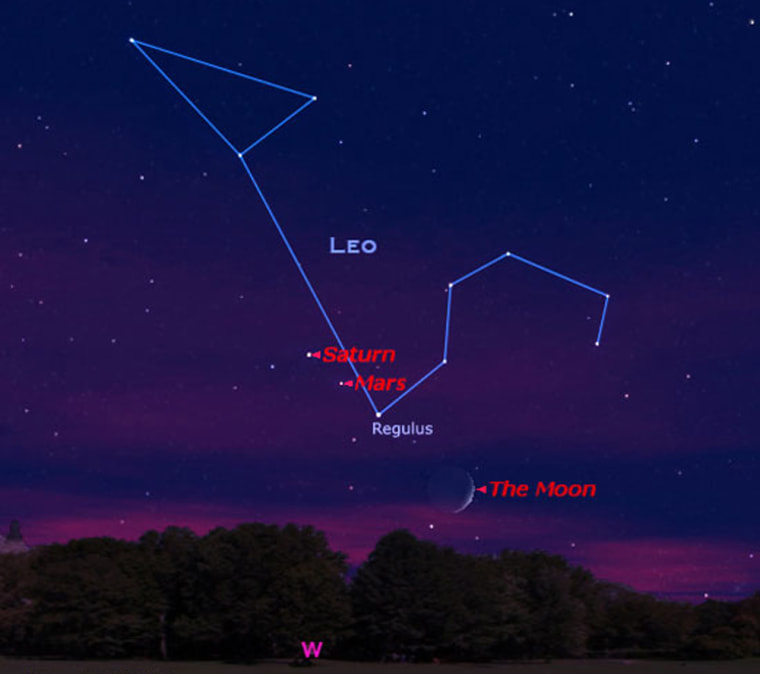Two bright planets will approach each other in our evening sky during the next couple of weeks. They are Mars, which was so brilliant during the Christmas season of 2007 and has since diminished dramatically in brightness, and Saturn, which has adorned our evening sky since midwinter.
Both worlds are now visible about one-third of the way up from the western horizon as darkness falls.
And as a bonus, located between these two planets is the bright star Regulus, in the constellation of Leo, the Lion. Yellow-white Saturn, shining sedately at magnitude +0.4, is located above and to the left of Regulus, while the much dimmer Mars appears below and to the right of Regulus. At magnitude +1.6, Mars has now fallen to the rank of second magnitude and appears only one-half as bright as Saturn. Regulus, meanwhile is roughly midway in brightness between the two planets.
On this scale of brightness, smaller numbers represent brighter objects.
If you watch the sky carefully through the next two weeks, you'll be able to take note of the changing positions of these two planets and nearby star, relative to each other.
Slideshow 12 photos
Month in Space: January 2014
On the evening of June 30, you'll see Mars just above and to the right of Regulus, while Saturn sits above and to the left; the trio will resemble an arrowhead that night with Saturn making the arrow's tip.
On the evening of July 1, Mars will appear perched almost directly above Regulus. The color contrast will be quite striking, especially in binoculars: Mars appears yellow-orange, while Regulus is bluish.
On July 5 looking low in the western sky about an hour after sundown, you'll see a waxing crescent moon, with Regulus, Mars and Saturn all oriented in a straight line in that order, from lower right to upper left. Mars will be situated almost exactly in between Regulus and Saturn. On the following night, the moon will have shifted eastward, forming a broad triangle with Regulus and Saturn, while Mars will have moved noticeably closer to Saturn.
Saturn-Mars interactions
Saturn, at a mean distance of 886.2 million miles from the sun, takes 29.46 years to move once around the sun. Mars, at a mean distance of 141.6 million miles from the sun, requires only 1.88 Earth-years to complete one journey around the sun.
As a result, Mars' normal eastward motion among the stars is considerably faster than that of Saturn. So from our vantage point here on the Earth, Mars will periodically seem to overtake Saturn in the sky.
During the evenings of July 9 through 11, watch how the faster-moving Mars closely interacts with the much slower Saturn. Despite the difference in brightness, they still should make for a rather eye-catching pair in the western twilight glow about an hour after sundown.
On July 9, Mars is situated about one degree below Saturn. On the 10th, they are closest together, separated by 0.7 degree; Mars now appears just below and to the left of Saturn. On the 11th, Mars has moved noticeably farther away to Saturn's left.
Interestingly, when we combine the motions of Earth, Mars and Saturn, we find that the interval between conjunctions of Mars and Saturn average about every 2 years and 20 days. The last time Mars and Saturn got together was June 17, 2006. Their next meeting is set for July 30, 2010.
Joe Rao serves as an instructor and guest lecturer at New York's Hayden Planetarium. He writes about astronomy for The New York Times and other publications, and he is also an on-camera meteorologist for News 12 Westchester, N.Y.

